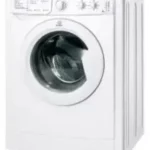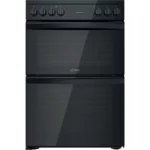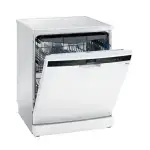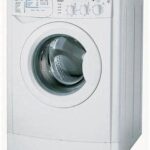
The Indesit Tumble Dryer Instruction Manual is a comprehensive guide on how to install and use the dryer. It provides detailed information on where to place the dryer, how to make electrical connections, and how to maintain the fluff filter. The manual also includes laundry instructions, such as the maximum load size, wash care labels, and items not suitable for tumble drying. Safety warnings are given to ensure safe usage of the appliance, including precautions when cleaning and using the dryer. The manual also provides information on how to choose a program and approximate drying times for different fabrics. Additionally, it includes power consumption data and troubleshooting suggestions to help solve common problems before calling the service center. Whether you are a first-time user or an experienced one, this manual is a valuable resource for anyone who wants to use their Indesit Tumble Dryer safely and efficiently.
INDESIT Tumble Dryer

INDESIT Tumble Dryer
Installation
WHERE TO PUT YOUR DRYER
The dyer should be placed where air can freely circulate around it preferably near a window that can be opened to reduce the possibility of condensation occurring while the dryer is in use.
If the dryer is enclosed or fitted under a work surface a gap of at least 50 mm (2”) must be allowed above the top for the full width of the dryer and at least 25 mm (1”) either side. This allows air to enter into the rear air inlet. The dryer must never be run in a cupboard with a closed door.
ELECTRICAL CONNECTIONS
The socket must be grounded. The power supply cord should be checked periodically and, if required, replaced by a cord specially prepared for this dryer.
FLUFF FILTER
You must clean the fluff filter after EVERY drying cycle.

To remove the filter
Step 1 – Open the door of your dryer, remove the filer.
Step 2 – Clean any fluff deposits from the filter mesh, and refit the filter.

Step 3 – Make sure the filter is pushed fully home – NEVER run the dryer without the filter in position.
Failure to clean the filter after EVERY drying cycle will affect the drying performance of your machine.

The dryer must never be installed behind a lockable door, a sliding door or a door with a hinge on the opposite side to that of the dryer door.
This symbol reminds you to read this booklet.
VENTILATION
When the dryer is in use there has to be adequate ventilation to avoid the back flow of gases into the room from appliances burning other fuels, including open fires.
The vent tube should not exceed 2.4 metres in length.
The tube should be kept clear of the air intake vent and kinks or ‘U’ bends must be avoided as these will obstruct the tube and trap condensation.
Laundry
MAX LOAD SIZE
Do not load more than maximum capacity. These numbers refer to dry weight:
Natural fibres: 4kg max Synthetic fibre: 2kg max
WASH CARE LABELS
Look at the labels on your garments, especially when tumble drying for the first time. The following symbols are the most common:

May be tumble dried

Do NOT tumble dry

Tumble dry at high heat setting

Tumble dry at low heat setting
ITEMS NOT SUITABLE FOR TUMBLE DRYING
- Articles that contain rubber or rubber-like materials or plastic film, any flammable articles or objects that contain flammable substances.
- Glass fibres.
- Items which have been dry cleaned.
- Large bulky items (quilts, sleeping bags, etc). These expand when drying and prevent airflow through the dryer
Warnings
! This appliance has been designed and built according to international safety standards.
These warnings are given for safety reasons and must be followed carefully.
GENERAL SAFETY
- This appliance can be used by children aged from 8 years and above and persons with reduced physical, sensory or mental capabilities or lack of experience and knowledge if they have been
given supervision or instruction concerning use of the appliance in a safe way and understand the hazards involved. - This tumble dryer has been designed for home, and not professional, use.
- Do not touch the appliance while barefoot or with wet hands or feet.
- Unplug the machine by pulling on the plug, not the cord.
- After using the dryer, turn it off and unplug it. Keep the door closed to make sure that children do not use it as a toy.
- Children should be supervised to ensure that they do not play with the dryer.
- Cleaning and user maintenance shall not be made by children without supervision.
- Children of less than 3 years should be kept away from the appliance unless continuously supervised.
- The appliance must be installed correctly and have proper ventilation. The air intake at the front of the dryer should never be obstructed (see Installation).
- Never direct the vent tube outlet towards the air intake at the back of the machine
- Never allow the tumble dryer to recycle exhaust air.
- Never use the dryer on carpeting where the pile height would prevent air from entering the dryer from the base.
- Check to see if the dryer is empty before loading it.
- The back of the dryer could become very hot. Never touch it while in use.
- Do not use the dryer unless the filter is securely in place (see Maintenance
- Do not overload the dryer (see Laundry for maximum loads).
- Do not load items that are dripping wet.
- Carefully check all instructions on clothing labels (see Laundry).
- Do not tumble dry large, very bulky items.
- Do not tumble dry acrylic fibres at high temperatures.
- Complete each programme with its cool tumble phase.
- Do not turn off the dryer when there are still warm items inside.
- Clean the filter after each use (see Maintenance).
- Do not allow lint to collect around the dryer.
- Never climb on top of the dryer. It could result in damage.
- Always follow electrical standards and requirements. (see Installation).
- Always buy original spare parts and accessories (see Service).
TO MINIMIZE THE RISK OF FIRE IN YOUR TUMBLE DRYER, THE FOLLOWING SHOULD BE OBSERVED
- Tumble dry items only if they have been washed with detergent and water, rinsed and been through the spin cycle. It is a fire hazard to dry items that HAVE NOT been washed with water.
- Do not dry garments that have been treated with chemical products.
- Do not tumble dry items that have been spotted or soaked with vegetable or cooking oils, this constitutes a fire hazard. Oil-affected items can ignite spontaneously ,especially when exposed
to heat sources such as a tumble dryer. The items become warm, causing an oxidisation reaction with the oil, Oxidisation creates heat. If the heat cannot escape, items can become hot enough to catch fire. Piling, stacking or storing oil-effected items can prevent heat from escaping and so create a fire hazard.If it is unavoidable that fabrics containing vegetable or cooking oil or those that have been contaminated with hair care products be placed in a tumble dryer they should first be washed with extra detergent – this will reduce, but not eliminate the hazard. The cool tumble phase should be used to reduce the temperature of the items. They should not be removed from the dryer and piled or stacked while hot. - Do not tumble dry items that have previously been cleaned in or washed in, soaked in or soiled with petrol/gasoline, dry cleaning solvents or other flammable or explosive substances. Highly flammable substances
commonly used in domestic environments including cooking oil, acetone, denatured alcohol, kerosene, spot removers, turpentine, - waxes and wax removers. Ensure these items have been washed in hot water with an extra amount of detergent before being dried in the tumble dryer.
- Do not tumble dry items containing foam rubber (also known as latex foam), or similarly textured rubber like materials. Foam rubber materials can, when heated, produce fire by spontaneous combustion.
- Fabric softener or similar products should not be used in a tumble dryer to eliminate the effects of static electricity unless the practice is specifically recommended by the manufacturer of the fabric softener product.
- Do not tumble dry undergarments that contain metal reinforcements eg. bras with metal reinforcing wires. Damage to the tumble dryer can result if the metal reinforcements come loose during drying.
- Do not tumble dry rubber, plastic articles such as shower caps or babies waterproof covers, polythene or paper.
- Do not tumble dry rubber backed articles, clothes fitted with foam rubber pads, pillows, galoshes and rubber coated tennis shoes.
- Remove all objects from pockets, especially lighters.
WARNING: Never stop the dryer before the end of the drying cycle .The final part of a tumble dryer cycle without heat (cool down cycle) to ensure that the items are left at a temperature that ensures that the items will not be damaged.
Dryer Description
Control panel

The HEAT button selects drying temperature.
OUT: LOW heat IN: HIGH heat
The Start Button has to be pressed to start a programme or to restart a programme if you open the door during a drying cycle.
The TIMER knob sets the drying time: rotate it clockwise, NEVER COUNTER-CLOCKWISE, until the indictor is pointing to the drying time you want to select.
Set the program knob to OFF to switch off the machine.
CHOOSING A PROGRAMME
- Plug the dryer into the electrical socket.
- Sort your laundry according to fabric type.
- Open the door and make sure the filter is clean and in place.
- Load the machine and make sure items are not in the way of the door seal. Close door.
- Set the temperature with the HEAT button. High heat for Cotton and synthetics. Low heat for delicates and acrylics.
- Select a drying time by rotating the TIMER knob clockwise.
- Press to start button and the drying programme starts.
The tables below show APPROXIMATE drying times in minutes. Weights refer to dry garment weights.
| Cottons – High (full) Heat | |||
| Drying times 800-1000rpm spin in washing machine | |||
| 1kg | 2kg | 3kg | 4kg |
| 30-40mins | 40-55mins | 60-70mins | 85-120mins |
| Synthetics – High (full) Heat | |
| Drying times on reduced spin in washing machine | |
| 1kg | 2kg |
| 20-30mins | 30-45mins |
| Acrylics – Low (gentle) Heat | |
| Drying times on reduced spin in washing machine | |
| 1kg | 2kg |
| 30-50mins | 50-70mins |
| Power Consumption | |||
| Off-mode (Po) – Watts | 0.00 | ||
| Left-on mode (Pl) – Watts | 0.00 | ||
| Programmes | Kg | kWh | Minutes |
| Standard Cotton* | 4 | 2.95 | 101 |
| Standard Cotton | 2 | 1.40 | 51 |
| Synthetics | 2 | 0.84 | 35 |
| *This is the reference programme for the energy label and suitable to dry normal wet cotton laundry. This is the most efficient programme in terms of energy consumption for drying wet cotton laundry. | |||
This data is also available on the website http://www.INDESIT.com/INDESIT
Troubleshooting
Before you call the service centre go through the following troubleshooting suggestions:
PROBLEM:
The dryer won’t start.
POSSIBLE CAUSES/SOLUTION:
- The plug is not in the socket or making contact.
- There has been a power failure.
- The fuse has blown. Try to plug another appliance into the socket.
- You are using an extension cord? Try to plug the dryer directly into the socket.
- The timer knob has not been set properly.
- The start button has not been pressed.
- The start button was pressed with the door open. Make sure the door is closed before pressing the start button.
PROBLEM:
It is taking a long time to dry.
POSSIBLE CAUSES/SOLUTION:
- The filter has not been cleaned.
- The temperature setting is not correct.
- The correct time has not been selected.
- The vent tube or air intake vent is obstructed.
- The items were too wet.
- The dryer was over loaded.
DISPOSAL OF OLD ELECTRICAL APPLIANCES
The European Directive 2002/96/EC on Waste Electrical and Electronic Equipment (WEEE) requires that old household electrical appliances must not be disposed of in the normal unsorted municipal waste stream. Old appliances must be collected separately in order to optimise the recovery and recycling of the materials they contain and reduce the impact on human health and the environment.
 The crossed out “wheeled bin” symbol on the product reminds you of your obligation that when you dispose of the appliance
The crossed out “wheeled bin” symbol on the product reminds you of your obligation that when you dispose of the appliance
it must be separately collected. Consumers should contact their local authority or retailer for information concerning the
correct disposal of their old appliance
Repairs and After Sales
For product help and advice, repairs, spare parts or accessories, we’re here to help.
For local repair engineers – 03448 111 606
ROI – 0818 313 413
UK standard local rate applies
ROI local Irish rate applies
For Parts and Accessories visit: parts.indesit.co.uk/shop
Please remember to register your appliance at www.indesitservice.co.uk to activate your 10 year parts guarantee
How to find your model and serial number:

DOWNLOAD RESOURCES
- INDESIT Tumble Dryer [pdf] Instruction Manual Tumble Dryer
- Read more: https://manuals.plus/indesit/tumble-dryer-manual#ixzz7ghMDyGM0
SPECIFICATION
| Product Specifications | Description |
|---|---|
| Brand | Indesit |
| Product Name | Tumble Dryer |
| Installation Requirements | Proper ventilation, grounded socket, gap of at least 50mm above the top and 25mm either side if fitted under a work surface |
| Fluff Filter Maintenance | Clean after EVERY drying cycle |
| Laundry Capacity | Natural fibres: 4kg max, Synthetic fibre: 2kg max |
| Wash Care Labels | May be tumble dried, Do NOT tumble dry, Tumble dry at high heat setting, Tumble dry at low heat setting |
| Items Not Suitable for Tumble Drying | Articles that contain rubber or rubber-like materials or plastic film, any flammable articles or objects that contain flammable substances, Glass fibres, Items which have been dry cleaned, Large bulky items (quilts, sleeping bags, etc) |
| Safety Warnings | Follow general safety precautions, keep away from children, proper installation and ventilation, do not overload or use on wet items, clean filter after each use, do not use fabric softener, do not tumble dry certain materials, do not stop dryer before end of cycle |
| Control Panel | HEAT button for temperature selection, TIMER knob for drying time, Start Button to start or restart program |
| Programme Selection | Plug in dryer, sort laundry by fabric type, clean filter, load machine, set temperature and drying time, press start button |
| Approximate Drying Times | Cottons – High (full) Heat: 30-40mins for 1kg, 40-55mins for 2kg, 60-70mins for 3kg, 85-120mins for 4kg |
| Power Consumption | Not provided in manual |
| Troubleshooting | Not provided in manual |
FAQ’S
Why is my Indesit dryer not drying my clothes?
We recommend the following: Ensure that the vent hose is not blocked or crushed. Ensure that your Indesit washer dryer is not being overfilled with clothing as this will impair the performance. Double check the heat switch on your dryer is set to the appropriate position.
Why is my dryer not heating up Indesit?
Failure to empty the water container can result in your Indesit machine not heating (your clothes may still be wet at the end of the drying cycle). To empty your water container, simply pull the container out towards you and remove it fully from the dryer.
How do I reset my Indesit tumble dryer?
Sometimes it may be on the back panel. So you won’t need to remove. It. To reset the heat on your tumble dryer press the red button in if it has tripped you should hear a click a.
Why is my dryer running but not heating?
Common reasons for an electric or gas dryer not heating are a tripped circuit breaker, clogged vent, and no gas flow. Other potential reasons include a faulty thermal fuse and broken heating element.
What is the button for on Indesit tumble dryer?
The HEAT button selects drying temperature. The Start Button has to be pressed to start a programme or to restart a programme if you open the door during a drying cycle.
What do the symbols on a tumble dryer mean?
A square with a circle inside means that the item can be safely tumble dried, while the number of dots inside the tumble dry symbol indicates what temperature setting to use: one dot stands for low heat, two dots for medium, and three for high heat setting. No dot means that you can tumble dry your clothes on any heat.
What do all the laundry symbols mean?
Washing temperature symbols
A single dot inside, this indicates an item should be washed cold at 85ºF (30ºC). Two dots indicate a warm wash temperature of 105ºF (40ºC). Three dots show a warm/hot wash of 120ºF (50ºC). Four dots mean a hot 140ºF (60ºC) wash. Five dots indicate a sanitizing 160ºF (70ºC) wash.
Do not tumble dry symbol meaning?
If your garment’s care label is showing the do not tumble dry laundry symbol, it means that the garment is delicate, cannot be placed in the dryer, and must be air or line dried. Tumble drying a delicate garment can lead to shrinkage, pilling, and other types of damage.
How do I clean my Indesit condenser dryer filter?
Dryer. Okay so first things first let’s clean out the lint filter. Which you find just inside the door and it simply lifts out and all you have to do is throw. All this slop in the bin.
How do I know if my dryer belt is broken?
First off if your drum doesn’t turn. It’s likely that your belt is either broken or off so you’re gonna want to get into that and remove the drum.
Can you use tumble dryer without belt?
Because the belt is what essentially rotates your drum and lets your clothes dry, the appliance will not be able to dry your clothes without it. It has a broken motor. Your dryer motor is what turns the belt that turns the tumbler. If the motor is broken, the dryer drum won’t turn.
Where is a dryer belt located?
The dryer belt goes around the outside of the drum and is looped onto a drive pulley attached to the dryer motor shaft which drives the belt, and around an idler pulley which applies tension to the belt.
What should I do to minimize the risk of fire in my tumble dryer?
To minimize the risk of fire in your tumble dryer, you should tumble dry items only if they have been washed with detergent and water, rinsed and been through the spin cycle. It is a fire hazard to dry items that HAVE NOT been washed with water. Do not dry garments that have been treated with chemical products. Do not tumble dry items that have been spotted or soaked with vegetable or cooking oils, this constitutes a fire hazard.
How do I choose a program for my Indesit Tumble Dryer?
To choose a program for your Indesit Tumble Dryer, plug the dryer into the electrical socket. Sort your laundry according to fabric type. Open the door and make sure the filter is clean and in place. Load the machine and make sure items are not in the way of the door seal. Close door. Set the temperature with the HEAT button. High heat for Cotton and synthetics. Low heat for delicates and acrylics. Select a drying time by rotating the TIMER knob clockwise. Press to start button and the drying programme starts.
What should I do if my dryer is not working properly?
If your dryer is not working properly, consult the troubleshooting section of the manual for suggestions on how to solve common problems before calling the service center.
VIDEO


INDESIT Tumble Dryer
www://indesit.co.uk/



